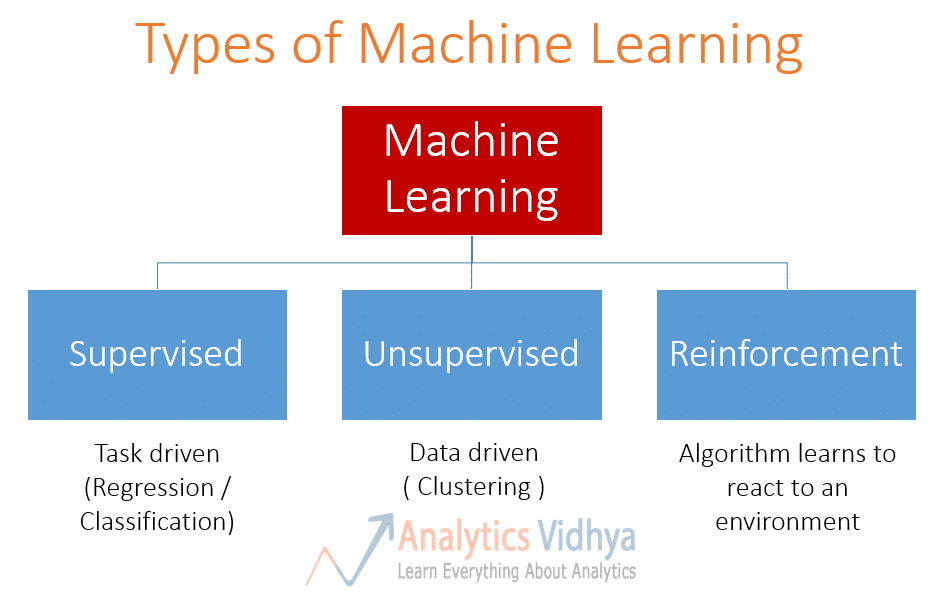Types of machine learning algorithms
- by 7wData

Regardless of whether the learner is a human or machine, the basic learning process is similar. It can be divided into four interrelated components:
Data storage utilizes observation, memory, and recall to provide a factual basis for further reasoning.
Abstraction involves the translation of stored data into broader representations and concepts.
Generalization uses abstracted data to create knowledge and inferences that drive action in new contexts.
Evaluation provides a feedback mechanism to measure the utility of learned knowledge and inform potential improvements.
Machine Learning algorithms are divided into categories according to their purpose.
Main categories are
Supervised learning (predictive model, "labeled" data)
classification (Logistic Regression, Decision Tree, KNN, Random Forest, SVM, Naive Bayes, etc)
numeric prediction (Linear Regression, KNN, Gradient Boosting & AdaBoost, etc)
Unsupervised learning (descriptive model, "unlabeled" data)
clustering (K-Means)
pattern discovery
Semi-supervised learning (mixture of "labeled" and "unlabeled" data).
Reinforcement learning. Using this algorithm, the machine is trained to make specific decisions. It works this way: the machine is exposed to an environment where it trains itself continually using trial and error. This machine learns from past experience and tries to capture the best possible knowledge to make accurate business decisions. Example of Reinforcement learning: Markov Decision Process.
There are lots of overlaps in which ML algorithms are applied to a particular problem. As a result, for the same problem, there could be many different ML models possible. So, coming out with the best ML model is an art that requires a lot of patience and trial and error. Following figure provides a brief of all these learning types with sample use cases.
The Supervised learning algorithms are a subset of the family of Machine Learning algorithms which are mainly used in predictive modeling. A predictive model is basically a model constructed from a machine learning algorithm and features or attributes from training data such that we can predict a value using the other values obtained from the input data.
Supervised learning algorithms try to model relationships and dependencies between the target prediction output and the input features such that we can predict the output values for new data based on those relationships which it learned from the previous data sets. The main types of supervised learning algorithms include:
Classification algorithms: These algorithms build predictive models from training data which have features and class labels. These predictive models in-turn use the features learnt from training data on new, previously unseen data to predict their class labels. The output classes are discrete. Types of classification algorithms include decision trees, random forests, support vector machines, and many more.
Regression algorithms: These algorithms are used to predict output values based on some input features obtained from the data. To do this, the algorithm builds a model based on features and output values of the training data and this model is used to predict values for new data. The output values in this case are continuous and not discrete. Types of regression algorithms include linear regression, multivariate regression, regression trees, and lasso regression, among many others.
Some application of supervised learning are speech recognition, credit scoring, medical imaging, and search engines.
The Unsupervised learning algorithms are the family of machine learning algorithms which are mainly used in pattern detection and descriptive modeling. However, there are no output categories or labels here based on which the algorithm can try to model relationships.
[Social9_Share class=”s9-widget-wrapper”]
Upcoming Events
Evolving Your Data Architecture for Trustworthy Generative AI
18 April 2024
5 PM CET – 6 PM CET
Read MoreShift Difficult Problems Left with Graph Analysis on Streaming Data
29 April 2024
12 PM ET – 1 PM ET
Read More




One thought on “Types of machine learning algorithms”
Very well said here i want to add a little is that these algorithms require extensive input from developers. An AI engineer must define the boundary and initial conditions along with the labeling of data-sets to make the distinction. I also read another post about introduction to categories of machine learning algorithms: https://mobinspire.com/blogs/introduction-to-categories-of-machine-learning-algorithms/
They outline the answers from a selected range to make the software learn patterns.